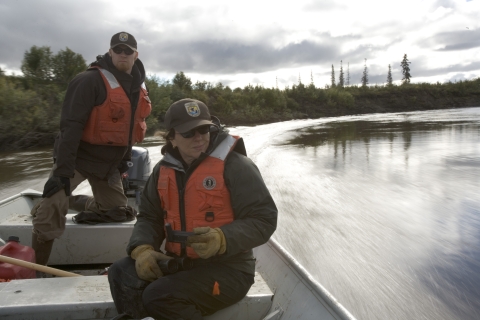What We Do
Wildlife conservation is at the heart of the National Wildlife Refuge System. In the wide-open spaces of northwest Alaska, the land is largely undeveloped, the rivers free-flowing, and the human population small. As a result, much of the work we do consists of "monitoring" both wildlife populations and environmental conditions. Climate change, which is accelerating in the Arctic faster than almost anywhere on Earth, is the biggest concern we have for the conservation of Selawik Refuge.
We also work to maintain relationships with tribes, local communities, regional organizations and partner agencies. It is important to us to communicate with our lifelong neighbors, build trust, and work together as resource stewards with Indigenous communities.
Management and Conservation
Management of Selawik Refuge is designed to maintain the natural environment of the refuge. Habitats are allowed to function and change through ecological processes. Our focus is on understanding ecological systems and monitoring the health of resources on refuge lands.
Public use of the refuge is encouraged for subsistence activities, hunting, fishing, wildlife viewing, photography, hiking, education, river floating and similar uses.
Special management actions apply to the Selawik Wilderness Area and the Selawik Wild River corridor, in order to preserve the particular values recognized in these places by Congress.
Our Projects and Research
Selawik Refuge, in cooperation with other researchers and agencies, works to monitor wildlife populations and gain a better understanding of the natural systems within refuge habitats.
We have begun a broad-based ecological research program, focusing on understanding entire landscapes and ecosystems rather than single species. Climate change is already apparent in the Arctic, and is expected to lead to profound shifts in ecosystem dynamics. To prepare for this, we must advance our knowledge of the basic structure structure
Something temporarily or permanently constructed, built, or placed; and constructed of natural or manufactured parts including, but not limited to, a building, shed, cabin, porch, bridge, walkway, stair steps, sign, landing, platform, dock, rack, fence, telecommunication device, antennae, fish cleaning table, satellite dish/mount, or well head.
Learn more about structure of our ecosystems, including nutrient and energy flows, food webs, soil and water chemistry, permafrost, and other landscape processes. Traditional wildlife monitoring can tell us how wildlife are affected by changes once they occur, but only a deep understanding of the ecosystem can help us anticipate change and monitor resources wisely.
Law Enforcement
We work in coordination with U.S. Fish and Wildlife Service Officers that cover the northern Alaska region, locally based Alaska Wildlife Troopers, NANA Trespass program and other agency partners to respond to law enforcement needs and issues.
